| Portrait | Name | Type | Dates opened | North Bank | South Bank | Maintained by |
|---|
 | Tower Bridge | Combination bascule / suspension | 1894 | Tower Hamlets | Southwark | Bridge House Estates |
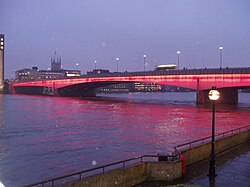 | London Bridge | Box girder | 50 AD
1209
1831
1973 | City of London: Monument | Southwark | Bridge House Estates |
 | Cannon Street Railway Bridge | Beam | 1866 | City of London: Cannon Street | Southwark | Network Rail |
 | Southwark Bridge | Arch | 1819
1921 | City of London: Queen Street | Southwark: Bankside | Bridge House Estates |
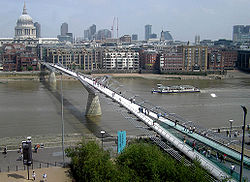 | Millennium Bridge | Suspension | 2000 | City of London: Queenhithe | Southwark: Bankside | Bridge House Estates |
 | Blackfriars Railway Bridge | Arch | 1864
1886 | City of London: Blackfriars | Southwark | Network Rail |
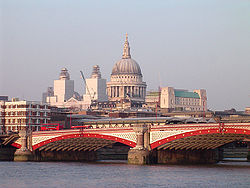 | Blackfriars Bridge | Arch | 1769
1869 | City of London: Blackfriars | Southwark | Bridge House Estates |
 | Waterloo Bridge | Box girder | 1817
1945 | Westminster | Lambeth: South Bank | Transport for London |
 | Hungerford Bridge | Lattice truss | 1864 | Westminster | Lambeth: South Bank | Network Rail |
| Golden Jubilee Bridges | Suspension | 2002 |
 | Westminster Bridge | Arch | 1750
1862 | Westminster | Lambeth: South Bank | Transport for London |
 | Lambeth Bridge | Arch | 1862
1932 | Westminster | Lambeth | Transport for London |
 | Vauxhall Bridge | Arch | 1816
1906 | Westminster: Pimlico | Lambeth: Vauxhall | Transport for London |
 | Grosvenor Bridge | Arch | 1859 | Westminster | Wandsworth | Network Rail |
 | Chelsea Bridge | Suspension | 1858
1937 | Kensington and Chelsea: Chelsea | Wandsworth: Battersea | Kensington and Chelsea London Borough Council |
 | Albert Bridge | Combined Ordish–Lefeuvre / suspension / beam | 1873 | Kensington and Chelsea: Chelsea | Wandsworth: Battersea | Kensington and Chelsea London Borough Council |
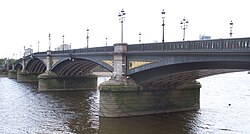 | Battersea Bridge | Arch | 1771
1890 | Kensington and Chelsea: Chelsea | Wandsworth: Battersea | Transport for London |
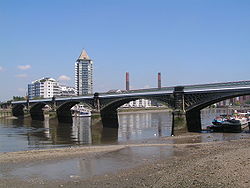 | Battersea Railway Bridge | Arch | 1863 | Hammersmith and Fulham: Imperial Wharf | Wandsworth: Clapham Junction | Network Rail |
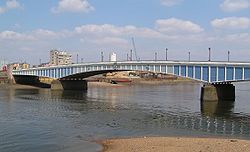 | Wandsworth Bridge | Cantilever | 1873
1938 | Hammersmith and Fulham: Fulham | Wandsworth: Wandsworth | Wandsworth London Borough Council |
 | Fulham Railway Bridge and Footbridge | Lattice girder | 1889 | Hammersmith and Fulham: Putney Bridge | Wandsworth: East Putney | Network Rail |
 | Putney Bridge | Arch | 1729
1886 | Hammersmith and Fulham: Fulham | Wandsworth: Putney | Wandsworth London Borough Council |
 | Hammersmith Bridge | Suspension | 1827
1887 | Hammersmith and Fulham: Hammersmith | Richmond upon Thames: Castelnau | Hammersmith and Fulham London Borough Council |
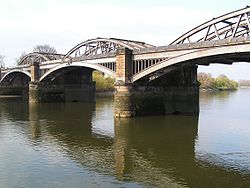 | Barnes Railway Bridge and Footbridge | Truss arch | 1849 | Hounslow: Chiswick | Richmond upon Thames: Barnes | Network Rail |
 | Chiswick Bridge | Deck arch | 1933 | Hounslow: Chiswick | Richmond upon Thames: Mortlake | Transport for London |
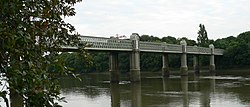 | Kew Railway Bridge | Lattice truss | 1869 | Hounslow: Gunnersbury | Richmond upon Thames: Kew Gardens | Network Rail |
 | Kew Bridge | Arch | 1759
1789
1903 | Hounslow: Brentford | Richmond upon Thames: Kew | Transport for London |
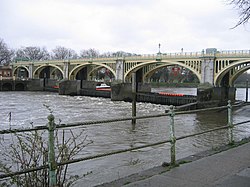 | Richmond Lock and Footbridge | Arch | 1894 | Richmond upon Thames: St Margarets | Richmond upon Thames: Richmond | Port of London Authority |
 | Twickenham Bridge | Arch | 1933 | Richmond upon Thames: St Margarets | Richmond upon Thames: Richmond | Transport for London |
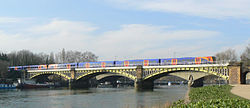 | Richmond Railway Bridge | Truss arch | 1848 | Richmond upon Thames: St Margarets | Richmond upon Thames: Richmond | Network Rail |
 | Richmond Bridge | Arch | 1777 | Richmond upon Thames: St Margarets | Richmond upon Thames: Richmond | Richmond upon Thames London Borough Council |
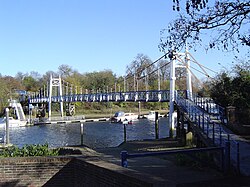 | Teddington Lock Footbridges | Girder (Eastern)
Suspension (Western) | 1889 | Richmond upon Thames: Teddington | Richmond upon Thames: Ham | Richmond upon Thames London Borough Council |
 | Kingston Railway Bridge | Arch | 1863 | Richmond upon Thames: Hampton Wick | Kingston upon Thames: Kingston | Network Rail |
 | Kingston Bridge | Arch | 1190
1828 | Richmond upon Thames: Hampton Wick | Kingston upon Thames: Kingston upon Thames | Kingston upon Thames London Borough Council |
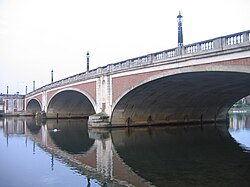 | Hampton Court Bridge | Arch | 1753
1778
1865
1933 | Richmond upon Thames: Hampton Court Palace | Surrey: East Molesey | Surrey County Council |
|


































